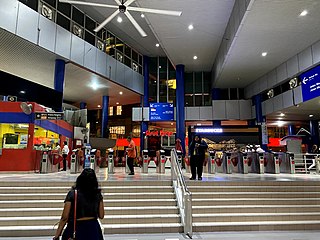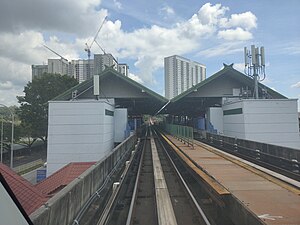Location
Taman Melati station is on the northern edge of Kuala Lumpur's city limits, 400 metres from the nearest Kuala Lumpur-Selayang border, and was built along Persiaran Pertahanan. In addition to serving its namesake location, Taman Melati, to the east, the station is also accessible from other surrounding housing estates, including Gombak Setia to the west (in east Gombak), Taman Setapak Jaya to the south (north of Setapak), and, to an extent, Taman Cemerlang to the north.
Taman Melati station is the last station northwards to Gombak, and is one of two Kelana Jaya Line stations serving the Taman Melati and Taman Cemerlang areas, the other being Gombak itself.

Rapid KL is a public transportation system owned by Prasarana Malaysia and operated by its subsidiaries Rapid Rail and Rapid Bus. The acronym stands for Rangkaian Pengangkutan Integrasi Deras Kuala Lumpur, which translates to Kuala Lumpur Rapid Integrated Transport Network in the Malay language. Rapid KL, with its 204.1 km (126.8 mi) of metro railway and 5.6 km (3.5 mi) of BRT carriageway, is part of the Klang Valley Integrated Transit System, operating throughout Kuala Lumpur and Selangor's satellite cities in the Klang Valley area.

The LRT Kelana Jaya Line is a medium-capacity light rapid transit (LRT) line and the first fully automated and driverless rail system in the Klang Valley, Malaysia. It forms part of the Klang Valley Integrated Transit System in and around Kuala Lumpur, Malaysia. Servicing 37 stations, the line has 46.4 km (28.8 mi) of grade-separated tracks running mostly on underground and elevated guideways. Formerly known as the PUTRA-LRT, it is operated as part of the Rapid KL system by Rapid Rail, a subsidiary of Prasarana Malaysia. The line is named after its former terminus, the Kelana Jaya station. The line is numbered 5 and coloured ruby on official transit maps.

Puchong is a major town and a parliamentary constituency in the Petaling District, Selangor, Malaysia.

Wangsa Maju is a township and a constituency in Kuala Lumpur, Malaysia. This area is surrounded by Setapak, Taman Melati and Gombak district in Selangor. Wangsa Maju is one of the major suburbs in Kuala Lumpur.

Setapak is a town and mukim straddling both norteastern Kuala Lumpur and Gombak District of Selangor, Malaysia.
Jalan Ampang or Ampang Road is a major road in the Klang Valley region, Selangor and the Federal Territory of Kuala Lumpur, Malaysia. Built in the 1880s, it is one of the oldest roads in the Klang Valley. It is a main road to Ampang Jaya and is easily accessible from Jalan Tun Razak or Jalan Ulu Klang from the Hulu Kelang or Setapak direction. It is also accessible from Cheras through Jalan Shamelin, from Jalan Tun Razak through Jalan Kampung Pandan via Taman Cempaka, from Kampung Pandan through Jalan Kampung Pandan Dalam via Taman Nirwana, from the Kuala Lumpur Middle Ring Road 2 via Pandan Indah and Taman Kencana and from Hulu Langat town through the mountain pass. Wangsa Maju, Setapak, central Kuala Lumpur, Ampang Park and Salak South surround Ampang. Jalan Ampang became the backbone of the road system linking Ampang to Kuala Lumpur before being surpassed by the Ampang–Kuala Lumpur Elevated Highway (AKLEH) in 2001.

Ampang Jaya, more commonly known as just Ampang, is a town, a mukim and a parliamentary constituency straddling parts of the Hulu Langat District and Gombak District, in eastern Selangor, Malaysia. It is located just outside the eastern border of Kuala Lumpur Federal Territory.

Masjid Jamek LRT station is a rapid transit station in Kuala Lumpur, Malaysia. It is the interchange station between two of Rapid KL's light rapid transit (LRT) systems, namely the LRT Ampang and Sri Petaling Lines and the LRT Kelana Jaya Line. The station is one of only two stations integrating the LRT lines, the other being Putra Heights station. The station is situated near and named after the Masjid Jamek in central Kuala Lumpur.
Sri Rampai LRT station is a rapid transit station in northern Kuala Lumpur, Malaysia, forming part of the Kelana Jaya line. The station, named after the nearby Taman Sri Rampai housing estate to the west, is located along the border between Taman Sri Rampai and Wangsa Maju to the east.

Asia Jaya LRT station is an elevated rapid transit station in Petaling Jaya, Selangor, Malaysia, forming part of the Kelana Jaya Line. The station was opened on September 1, 1998, as part of the line's first segment encompassing 10 elevated stations between Kelana Jaya station and Pasar Seni station, and the line's maintenance depot in Lembah Subang.

The Pasar Seni station is an integrated rapid transit station in Kuala Lumpur that is served by the LRT Kelana Jaya Line and the MRT Kajang Line. The station is named after the nearby Central Market and is located near Petaling Street and the area known as the Chinatown of Kuala Lumpur.
Kampung Baru LRT station is an underground rapid transit station, named after and serving Kampung Baru, Kuala Lumpur, in Malaysia. The station is part of the Kelana Jaya Line. The station was opened on June 1, 1999, as part of the line's second and latest extension, which includes the addition of 12 stations, and an underground line that the Kampung Baru station is connected to. The Kampung Baru station is currently one of only five underground stations in the Kelana Jaya Line.

Damai LRT station is an elevated rapid transit station in Kuala Lumpur, Malaysia, forming part of the Kelana Jaya line. The station was opened on 1 June 1999, as part of the line's second segment from Pasar Seni to Gombak. It is one of the 13 stations between Masjid Jamek and Gombak.

Setiawangsa LRT station is an elevated rapid transit station in Ampang, Malaysia, served by the LRT Kelana Jaya Line. The station was opened on June 1, 1999, as part of the line's second segment encompassing 12 stations between Masjid Jamek and Gombak and an underground line.

Wangsa Maju LRT station is an elevated rapid transit station in Wangsa Maju, Kuala Lumpur, Malaysia, forming part of the Kelana Jaya line. The station opened on 1 June 1999, as part of the line's second segment encompassing 12 stations between Kelana Jaya station and Terminal PUTRA and an underground line.

Gombak LRT station is a light rapid transit (LRT) station in the Gombak District, Selangor, Malaysia. It is the northern terminus of the LRT Kelana Jaya Line.

Abdullah Hukum station is an integrated rapid transit station in Kuala Lumpur, Malaysia, served by both the LRT Kelana Jaya Line and the KTM Komuter Port Klang Line.
Taman Melati is a Malay majority township in Wangsa Maju, Kuala Lumpur, Malaysia. It is located between Gombak, Klang Gates, Wangsa Maju city centre and Taman Melawati. The 5 Kelana Jaya Line's KJ2 Taman Melati LRT station is situated in this area.

Puchong Prima LRT station is a Light Rapid Transit station at Puchong Prima, a township in Puchong, Petaling District, Selangor, Malaysia. It is served by the LRT Sri Petaling Line, which is situated between the terminus of the line, Putra Heights station and Puchong Perdana station.
Gombak is a locality in the mukim of Setapak in the coterminous Gombak District, Selangor, Malaysia.















